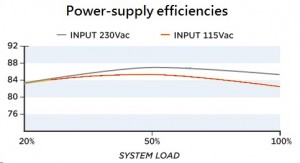The vast majority of computing and communications equipment consists of circuitry that requires very stable supply voltages, usually at 3V, 5V and 12V DC. Because the electronics is supplied at fixed voltage, its power consumption depends entirely on what it is doing and is completely insensitive to mains supply voltage. Fluctuations in mains voltage are dealt with by having stabilised power supply units (PSUs), which these days are commonly engineered to accept AC inputs anything between 100V and 240V while giving the rock-steady DC output that the equipment needs.
 PSUs are not loss-free. At 87% efficiency, 100W of useful DC output incurs 14.9W of heat loss (100/114.9=0.87). There is much competition between manufacturers to reduce these losses and the sales specification sheets now usually sport a chart like the one above, showing how PSU efficiency changes with loading. Peak efficiency (minimum loss) typically occurs at about half load. But what these charts also disclose is that losses are higher at lower voltage. The difference in this case (230V versus 115V) is extreme, with losses increasing from roughly 15% to 18% as a percentage of output power.
PSUs are not loss-free. At 87% efficiency, 100W of useful DC output incurs 14.9W of heat loss (100/114.9=0.87). There is much competition between manufacturers to reduce these losses and the sales specification sheets now usually sport a chart like the one above, showing how PSU efficiency changes with loading. Peak efficiency (minimum loss) typically occurs at about half load. But what these charts also disclose is that losses are higher at lower voltage. The difference in this case (230V versus 115V) is extreme, with losses increasing from roughly 15% to 18% as a percentage of output power.
Admittedly a reduction of a few volts would only add a fraction of a percentage point to the PSU losses, but neveretheless although conventional wisdom is that voltage reduction has no effect on energy consumption in computer equipment, the truth is that it should actually incur a slight penalty.
If the IT equipment is in an air-conditioned environment, then what effect will voltage reduction have on chiller power? It depends how it is controlled but either the chillers’ outputs will fall, causing them to run longer to make up the deficit, or their control systems will maintain the requisite output, causing them to demand the same electrical input power. Either way, no saving on input power; you cannot get out more than you put in, and in fact the reduction of condenser cooling fan flow might well compromise the coefficient of performance, causing the chiller installation to use rather more input energy than at the higher voltage.
All in all, not a good prognosis for voltage reduction with IT equipment; and that is without mentioning the fact, often glossed over, that the voltage-reduction gear itself incurs energy losses.